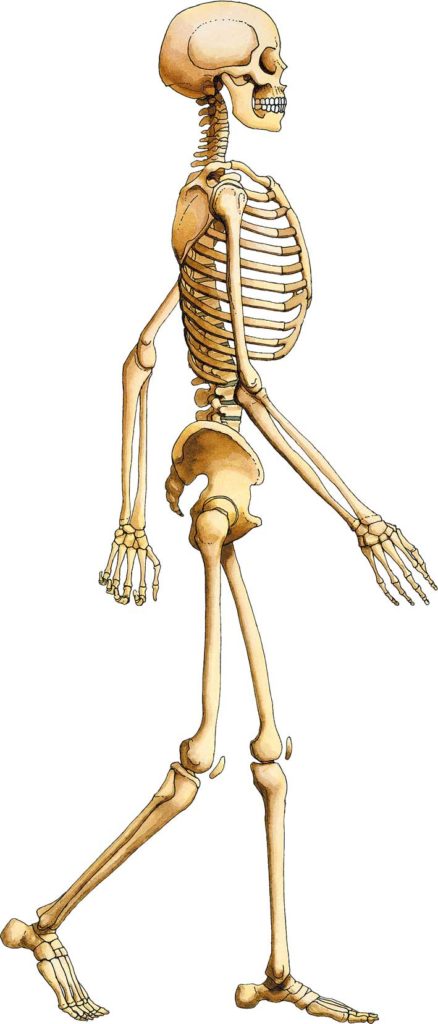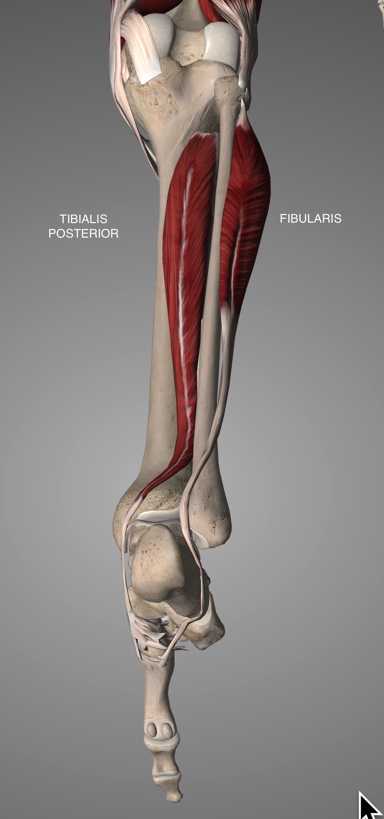WALKING GAIT
GRIP
ANATOMY OF GAIT
TURNING
ANATOMY OF TURNING
RUNNING GAIT
USE OF ARMS IN WALKING AND RUNNING
Walking gait comprises two phases. These are demonstrated in the short video following these descriptions1:
1) LOAD-BEARING PHASE: The whole foot makes contact with the ground, with the bodyweight centered of the Gait Line line indicated in the short video below. We can only accomplish this if our center of mass is nearly directly above the load-bearing foot. If there is “heel strike” or we load our mass on the outside edge or only on the ball of the foot, our center of gravity is miss-aligned with our gravitational centerline.
2) PUSH-OFF PHASE: The part of the ball of the foot behind the big toe and the big toe propel the body forward (note that the Push-Off line is parallel to, but medial of the Load-Bearing line). In this phase, there is potentially a great deal of control of stability and direction using the part of the ball behind the big toe. Minor corrections to direction, or adjustments to our center of gravity, occur seamlessly when this phase of gait is active. A side note is that the contralateral eye becomes dominant. When the ball of the right foot is active, the left eye should become dominant.
At the end of the Push-Off Phase, we can push ourselves forward using only the Big-Toe (see image at right for an example). Once our mass is moving, it takes very little energy to maintain momentum this way.
Many thanks for the donation of graphics assistance to Timothy Zgraggen
LinkedIn: https://www.linkedin.com/in/tim-zgraggen-83717b17/
Website: https://www.bigpixels.tv/
1 There is some difference of opinion as to the nature of optimized gait, and so gait is described here in the context of this discussion:
STANDARD OF CARE OF FEET
GRIP
It is crucial for effective gait that the feet fully grip the ground. Lacking the sensory refrence that the friction between the foot and the ground provides, the motor skills of posture and gait will not develope. The reflexive, automatic qualities of these functions are easily experienced by noticing how our bodies respond when we slip while walking on a slick surface. The response is as close to instantaneous as anything we can experience, initiating long before our conscious awareness that our footing is unstable.
Bare feet are the easiest way to access this function, but if this is not an option, evaluating this function in selecting footwear is recommended.
In addition to sensory feedback, the TENSEGRITY quality of properly stacked posture in GRAVITY is established on top of firm contact between the sole and a stiff surface.
POSTURAL EXTENSION
is a primary aspect of the Gait Line. There is a brief discussion on this in the section on STANDING. There is a more complete discussion in the section on the LOCOMOTIVE CORE. The guidelines for foot function discussed here facilitate switching on the body’s mechanism of postural extension. Conversely, the body’s postural extension provides the foundation for motor control of the feet in moving and turning. When we express Postural Extension in our gait, we “have a bounce in our step”.
Postural Extension is the consequence of the integration of the Foot Tendon Guard and Trunk Extension Developmental Reflexes.
ROLE OF THE OUTSIDE OF THE FOOT IN OPTIMIZED GAIT
If the foot is properly oriented to the vector of gait the outside edge can be utilized to push the mass of the body medially towards the center of gravity of the body. If the foot is everted, the outside edge of the foot can only be used to push the body forward. Using the foot in this way isolates gait from a primary balancing mechanism in the body. This statement is expanded upon in the section on One-Leg Stance in the Standing paper.
ANATOMY OF GAIT
The anatomical mechanisms enabling gait pervade from the bottom to the top of the body. In the feet, these are the plantar muscles of the foot, and the powerful muscles of the calf – the Gastrocnemius and Soleus. When these muscles are used in gait they not only provide powerful forces for moving forward but also store the energy needed to hold the body upright in gravity, returning that energy to the next step.
There is a more complete description of the anatomy and physiology of feet here:
ANATOMY AND PHYSIOLOGY OF FEET
TURNING
The part of the ball of the foot behind the big toe can be used dynamically in turning. Instead of pushing off with the big toe, we push off with the inside or outside edge of this part of the ball of the foot. The distinctions are illustrated in the video below. These distinctions may seem “nitpicky”, but they involve a dedicated musculoskeletal system used primarily for this purpose. They are extensions of the “Push-Off” phase of gait in the video above. When this mechanism is active in gait it affords a dramatically different experience of moving around which is much more responsive and controlled than what normal turning looks like.
A side note is that the contralateral eye becomes dominant. When the ball of the right foot is active, the left eye should become dominant.
Many thanks for the donation of graphics assistance to Timothy Zgraggen
LinkedIn: https://www.linkedin.com/in/tim-zgraggen-83717b17/
Website: https://www.bigpixels.tv/
ANATOMY OF TURNING
The anatomical mechanism enabling turning is comprised of two muscles, Fibularis, and Tibialis Posterior which drives the big Toe contact surface. The lateral muscle drives the body medially and vice verse. When these muscles work together they assist the large power muscles in the Push-Off Phase of gait. These two muscles add inflection to gait. If this mechanism is not intentionally used it will tend to atrophy and the muscles will become stiff and inflexible (hypertonic and hypoactive). However, functionality is usually recoverable with intentional use.
There is a more complete description of the anatomy and physiology of feet here:
ANATOMY AND PHYSIOLOGY OF FEET
RUNNING GAIT
In optimal running gait, much of the energy used to keep us upright and moving ahead is captured and returned to the next stride of that leg. To enable this dynamic, primary contact with the ground through the ball of the foot is needed. The more heel strike there is, the less efficient gait becomes – the energy that could be captured is dissipated into the body as shock waves, or hopefully into the ground. There is a detail discussion on this in the section on TENSEGRITY. If heel-strike occurs, the shock absorption mechanism in the Fibula comes into play. This is very likely to occur if running on hard, flat surfaces like concrete. When an abrupt shock load translates though the foot the energy is dissipated through the Fibula on the outside of the leg instead of being stored for the next stride, preventing high energy pressure waves from passing through the joints. Optimal running gait looks a lot like the “Push Off Phase” in the Gait Video above.
WALKING UP AND DOWN (IN/OUT) STAIRS
Very important to line up the bend alignment of the knee with the direction the big toe is pointing in. Because most stairs are more narrow than the length of our feet we will place the foot diagonally on the stair. However, we can easily try to keep the knee tracking in our direction of travel, which puts torque on the ligaments of the knee (rotating the front of the lower leg away from the body midline). Consciously aligning the bend of the knee with the pronated foot puts less stress on the knee.
USE OF ARMS IN WALKING, RUNNING AND TURNING
When we walk if we do not use our arms to counterbalance the forward motion we would tend to rotate rather than move forward. Therefore our arms play an essential role in our evolution to bipedal gait. In the “Push Off Phase” of gait, the opposing arm is pulled forward, and the homolateral arm pulled backward, neutralizing torque on the body (the Thumb should point forward as in the Skeleton graphic above). This is an Automaticity of our Gait Reflexes.
You can experience how the effect of the momentum of our arm on gait by trying to walk while holding your arms to your sides, or trying Homolateral Gait where the arm and leg on the same side move forward together.
META READING
An overview of the foot training protocols available on this website:
FOOT STRUCTURE AND FUNCTION
An overview of foot structural and functional issues and means to optimize how we use our feet:
FEET
An overview of the core physiological structure and functions of which feet are an essential attribute:
LOCOMOTIVE CORE
and a discussion of human neurophysiology dissected by physiology:
THE FOUR CORES
An overview of the several models describing the expression of Life through the form of our species:
EVOLUTIONARY PARADIGMS


